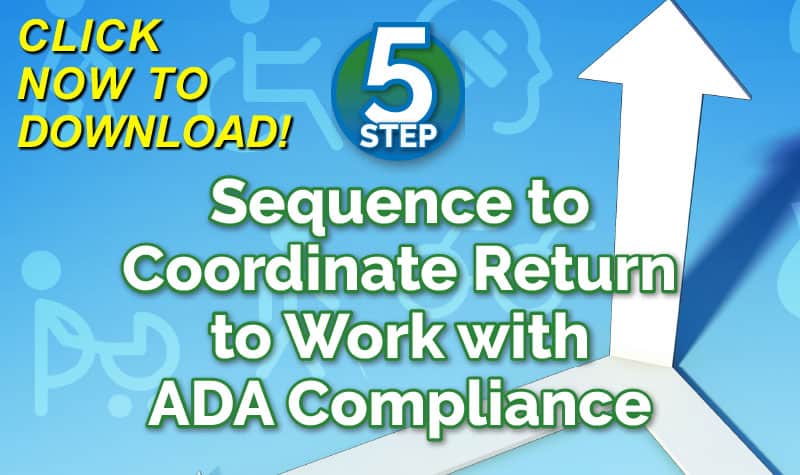The Americans with Disabilities Act (ADA) requires covered employers to provide reasonable accommodations to disabled employees. Despite this requirement, many employers maintain leave policies that are inflexible as to either the length of leave or the ability to request a different work assignment or other accommodation upon return from leave. Over the last few months, the U.S. Equal Employment Opportunity Commission (EEOC) has made headlines for its increased scrutiny of inflexible leave policies. One case in particular illustrates the perils for employers that fail to heed the requirements of the ADA in fashioning leave policies.
Click Link to Access Free PDF Download
“5-Step Sequence to Coordinate Return-to-Work with ADA Compliance”
On September 29, 2009, the Eastern District of Illinois approved a $6.2 million consent decree, the largest ADA lawsuit settlement in the history of the EEOC. The EEOC initiated the class action due to Sears’ policy of terminating employees out on workers’ compensation leave upon the expiration of the organization’s one-year maximum leave period. According to the EEOC, Sears not only refused to consider reasonable accommodations in the form of extended leave, but also refused to allow employees to return to work in a different capacity. The EEOC claimed to discover over a hundred former employees who wanted to return to work with an accommodation but who were terminated by Sears.
In addition to the record-setting monetary relief, the decree enjoins Sears from any future disability discrimination, as well as retaliation for opposing any unlawful disability discrimination. The consent decree extends for a three year period following the entry of the order, and the district court retains jurisdiction over the parties in the event that either party claims that the decree is violated. The decree provides for significant oversight over Sears’ compliance with both the order and the ADA more generally, including the following:
Notice. The decree provides that Sears must post a one-page notice of the decree on the employee bulletin board in every Sears location. The notice must be posted within 21 calendar days of the entry of the judgment and Sears is required to provide certification of compliance to the EEOC. The notice must remain posted for 3 years from the date of entry of the decree.
Recordkeeping. Sears must now maintain records of all attempts to accommodate employees on workers’ compensation leave within 45 days from the expiration of the maximum leave allowed under Sears’ leave of absence policy. Sears is required to make these records available to the EEOC within 10 days after demand.
Reporting. Sears is also required to submit semiannual reports to the EEOC, beginning 6 months after the entry of the consent decree and extending through 3 years after the decree is entered. The report must document: every individual on workers’ compensation leave within 45 days from the expiration of the maximum leave allowed; healthcare information relating to those employees’ most recent status; a list of all open positions at the Sears location from the time each employee’s leave began through the end of the leave period; and the last known contact information for each employee. Sears must be available upon the EEOC’s request to meet with the EEOC to discuss the report.
Training. All employees of the Centralized Leave Management Team-a team also created by the decree-must be trained by EEOC-approved individuals. The training must include the duty to accommodate under the ADA, the intersection of the ADA and workers’ compensation laws, and Sears’ specific procedures for providing accommodations to employees on leave of absence due to a workers’ compensation injury. The first training must take place within 90 days of the entry of the decree, and the duty to train continues through the following 3 years. Sears must notify the EEOC within 5 days after each training session to certify that the training occurred and that the required personnel attended. Sears must also provide the EEOC with the date, location, and duration of the training, and a copy of an attendance list.
Policies. The decree requires Sears to revise its policies within 28 days of the date of entry of the consent decree. The policies must provide for notification of employees within 45 days of the expiration of the leave period. The notice must inform the employee of the right to request a reasonable accommodation and specifically list reasonable accommodations, such as modified duty, part-time work, reassignment, additional leave, assistive devices, and relocation to other Sears locations. In addition, Sears must establish a centralized leave management team responsible for ensuring ADA compliance of the workers’ compensation leave policy. The termination of employees out on workers’ compensation leave must be approved by the team.
Notice to employees out on leave. Finally, Sears must revise the documents it provides to employees out on workers’ compensation leave within 28 calendar days of entry of the decree. Sears must send such employees a letter 45 days prior to expiration of their leave informing the employees of their ability to request a reasonable accommodation and specifically listing the reasonable accommodations discussed above. In addition, Sears must revise its health care provider certification to be sent at the same time to request the provider to list major life activities in which the employee is limited and identify any recommended accommodations, including reassignment. Finally, for employees who fail to respond, Sears must send a second letter 10 days before the expiration of leave . The letter must restate employees’ right to request reasonable accommodations and warn that failure to respond may result in termination.
Lessons for Employers
The sheer magnitude of the monetary, injunctive, and other relief provided in the Sears consent decree illustrates the risks faced by employers who maintain inflexible leave policies. But aside from terminating an injured worker whose leave has expired without considering possible reasonable accommodations, what options are available to employers? The parameters of the consent decree offers a few principles to ensure that employers’ leave policies and practices are in line with the ADA:
- Coveredemployers should never have a black and white policy on the maximum length leave available to employees. Employers must at least be willing to consider a longer period if necessary to reasonably accommodate the employee’s disability, and employees on leave should be notified of this right.
- Disabledemployees must be considered for open positions that they are qualified for on the same basis as other employees. Any program that restricts certain light-duty jobs to a certain class of individuals, for instance, is likely to run afoul of the ADA. (workersxzcompxzkit)
- Finally,covered employers should consider providing notice to employees on leave about their ability to apply for reasonable accommodations throughout the leave process. By offering examples of reasonable accommodations, employers increase the likelihood that courts will view the notice process as sufficient.
Given the current economic and political climate, the EEOC’s aggressive enforcement of the ADA is not likely to diminish any time soon. Employers who do not ensure the compliance of their leave policies may face similarly burdensome monetary awards and EEOC oversight of their leave policies and decisions.
Authors: Carl Lehmann and Bryan Seiler http://www.gpmlaw.com
Carl Lehmann is a member of Gray Plant Mooty’s Employment Law practice group and is co-chair of the firm’s Higher Education practice team. Carl’s practice includes advising employers in personnel-related matters, including terminations, discrimination and harassment issues, defamation claims, employment and independent contractor agreements, noncompete and confidentiality agreements, wage-hour compliance, voluntary and mandatory affirmative action policies, and insurance issues. Carl’s practice also includes assisting higher education institutions with various legal compliance issues including student disciplinary proceedings, accreditation, tenure and promotion, faculty manuals, Title IV and Title IX compliance, student privacy, and campus security matters. He can be contacted at Carl.Lehmann@GPMLaw.com http://www.gpmlaw.com
Bryan Seiler is an associate at Gray Plant Mooty and practices in the areas of employment and labor law and litigation. He served as a summer associate with the firm in 2008. While in law school, Bryan was actively involved in myriad organizations at the University of Minnesota including the Christian Legal Society, Minnesota Justice Foundation, and the Public Interest Law Students Association. He also gained experience as a summer law clerk for a plaintiff’s employment law firm in 2007 and for the Southern Minnesota Regional Legal Services’ Housing Equality Law Project in 2006. Prior to going to law school, Bryan worked in the District Office of then-U.S. Senator Barack Obama as a constituent services intern. Bryan is originally from Dallas, Texas and is an avid Dallas-area sports fan. He can be contacted at bryan.seiler@gpmlaw.com http://www.gpmlaw.com
Submit articles to: Info@WorkersCompKit.com.
FREE WC IQ Test: http://www.workerscompkit.com/intro/
WC Books: http://www.reduceyourworkerscomp.com/workers-comp-books-manuals.php
TD Calculator: www.ReduceYourWorkersComp.com/transitional-duty-cost-calculator.php
NEW ARTICLE: Return to Work in Unionized Companies
http://reduceyourworkerscomp.com/Return-to-Work-Programs-Unionized-Companies.php
Do not use this information without independent verification. All state laws vary. You should consult with your insurance broker about workers’ comp issues.
©2009 Amaxx Risk Solutions, Inc. All rights reserved under International Copyright Law. If you would like permission to reprint this material, contact Info@WorkersCompKit.com.









